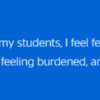Over 34 million children in the United States under the age of 18 have experienced at least one type of serious childhood trauma, according to the National Survey for Children's Health—and the numbers may be even higher, due to category omissions such as poverty and racism.
These stunning statistics are a heartbreaking reality for our children and a daily struggle for teachers. With nearly half of the children in our nation's classrooms experiencing adverse childhood events, trauma, or chronic trauma, teachers face the herculean feat of trying to reach children who simply do not feel safe enough to be reached, let alone ready to learn.
With such an overwhelming number of children facing trauma, it can be easy for educators to lose hope or burn out. They, and others in caring professions, can face "vicarious trauma," more commonly known as compassion fatigue—the cumulative, detrimental effect of working with survivors of traumatic life events. Symptoms can include insomnia, substance abuse, inability to focus, memory impairment, anxiety, depression, isolation, chronic fatigue, and more. So how can educators protect themselves from the many possible effects of vicarious trauma? Our Center for Special Education's Institute for Trauma Sensitivity (LIFTS) has some ideas.
1. Know what is yours to do.
2. Let go of the result.
3. Develop a self-care strategy.
4. Create a strong network.
5. Be authentic.
6. Practice mindfulness.
To read the Lesley University article, please click here.



Comments (0)